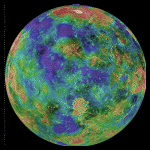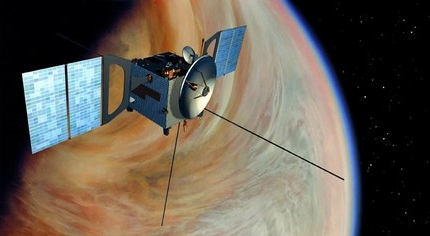 |
|||||||
| VENUS IS A BURNING-DESERT WORLD | |||||||
|---|---|---|---|---|---|---|---|
| Planet | Water | Greenhouse | Lightning | Spacecraft | Express | Transit | Resources |
European Space Agency interplanetary spacecraft:
Venus Express to Probe the Second Planet
Countdown clock: Arrival in orbit over Venus is expected April 11, 2006.
The European Space Agency launched Venus Express on November 9, 2005, to explore the second planet out from the Sun.
An ESA artist's vision of Venus Express over Venus.
The interplanetary probe is Europe's first-ever mission to Earth's nearest planetary neighbor. It's the first Venus mission from Earth in more than a decade. Only the United States and Russia have sent spacecraft to Venus in the past.
The voyage. After a 153-day cruise to Venus, Venus Express will enter a 24-hour elliptical polar orbit around that planet on April 11, 2006. The spacecraft's orbit will reach down to an altitude of 155 miles above the planet and out as far as 41,010 miles away from the planet.
Venus Express will begin its science work in July 2006. The spacecraft is expected to work for at least the equivalent of 500 Earth days in Venus orbit.
Tested design. To study that atmosphere, and make the first radar soundings below the planet's surface, Venus Express reuses the basic spacecraft design of ESA's successful Mars Express probe and carries the kind of instruments originally developed for the Mars Express and Rosetta probes. ESA's Mars Express has been sending spectacular images of the Red Planet to Earth since the end of 2003. Rosetta was launched in 2004 toward a comet.
Venus Express does not land on Venus. It stays in orbit above the planet, peering down into the environment from the top of the atmosphere down to the surface.
Launch. Russia launched Venus Express on a Soyuz-Fregat rocket from its Baikonur Cosmodrome in Kazakhstan.
The Russians won the assignment by successfully blasting the Mars Express spacecraft to the Red Planet on a Soyuz rocket from Baikonur on June 2, 2003.
Venus Express is controlled by the European Space Operations Centre in Darmstadt, Germany.
Science. The probe will explore the Venusian atmosphere where scientists want to understand the origin of violent winds that blow around the planet. It carries a set of instruments to study the thick and mysterious atmosphere of Venus.
Astronomers also want to understand why Earth and Venus developed in radically different ways.Venus and Earth were formed about 4.6 billion years ago.
- Venus is similar in diameter and mass to Earth, with a a similar composition, yet that planet has evolved differently, with a surface temperature hotter than a kitchen oven — in fact, hot enough to melt lead.
- Venus is enveloped by a thick atmosphere that is 95 percent carbon dioxide and a choking mixture of other noxious gases. It contains very little water vapor.
- The atmosphere is like a blanket trapping incoming solar radiation to heat the planet's surface to an average temperature of 872°F. That's hotter than the surface of Mercury, even though Venus is twice as far from the Sun and is bathed in only one-quarter of the amount of sunlight that falls on Mercury.
- The pressure at the planet's surface is 90 times that on Earth. Some interplanetary probes sent from Russia to land on Venus in the 1960s were crushed by the intense pressure before they could land. Even if people could walk on the surface, it would be difficult – like walking on the bottom of a half-mile-deep ocean on Earth.
- Winds in the upper atmosphere blow at more than 200 mph, while on the surface they are just a gentle breeze. However, because of the dense atmosphere at the surface, that easy breeze would have the effect on a person of being hit by a automobile.
The planet rotates counterclockwise, opposite Earth and most other planets. The rotation is very slow. A day on Venus equals 243 days on Earth.
Scientists wonder why the surface of Venus appears to have to no craters from old comet or asteroid impacts.
Some speculate that a crashing comet or asteroid in the distant past might have slowed the planet's rotation and reversed its spin direction. Could such an event have generated powerful volcano eruptions that smoothed over the planet's surface?
Venus. Venus is the third brightest body in our sky after the Sun and Moon. Because of that, it has been observed by all the great civilizations from ancient times until now, including Mayans, Egyptians, and Greeks. As early as 1600 B.C., the Babylonians kept detailed records of its movement across the sky.
A different ESA artist's view of Venus Express over Venus.
In modern times, due to the popularity of Mars, it has not been widely appreciated that the planet closest to Earth is Venus. In fact, Venus comes twice as close to our planet as Mars ever does.
While Venus is Earth's twin in size and mass, it has evolved quite differently. For instance, the temperature at its surface is hotter than an oven. Its air is a choking mixture of noxious gases.
As close as it is to Earth, Venus has been an understandable target for interplanetary probes from Earth. Previously, Russians and Americans have sent spacecraft to Venus. The most advanced was NASA's Magellan radar mapper.
The atmosphere. Scientists find several things puzzling about Venus. One main set of questions concerns the atmosphere:European scientists and engineers designed Venus Express to be the first interplanetary probe to perform a global investigation of the Venusian atmosphere and the plasma environment.
- What are the atmosphere's global characteristics?
- How does the atmosphere circulate?
- How does its composition change from top to bottom?
- How does its lowest region interact with the surface?
- How does its upper region interact with the solar wind?
While the planet rotates once every 243 Earth days, hurricane-force winds in the upper atmosphere take just four days to sweep around Venus.
The surface. Down on the planet's surface, the oldest craters seem to be only 500 million years old. Could that may mean the planet behaves like a volcanic pressure cooker?
On Earth, the shifting of the surface causing earthquakes and the repeated eruption of volcanoes ensure the energy build up inside our planet is dissipated gradually.
On Venus, things may work differently. Pressure may build inside the planet until the whole world is engulfed in a global eruption. That would resurface the planet and erase any craters that had formed. Scientists wonder if that happened about 500 million years ago. Venus Express will send home data shedding light on the mysteries.
Magellan. The last previous visitor was NASA's Magellan mapping probe, which left Earth back in 1989 and fell into orbit around Venus in 1990. During more than 15,000 orbits around the planet from then through 1994, Magellan's radar sent back spectacular images of mighty volcanoes, vast rifts and sharp-edged craters that were used to create a detailed map of 98 percent of the surface of Earth's cloud-shrouded sister planet.
Japan plans to launch an interplanetary spacecraft it calls Venus Climate Orbiter in 2008.
Learn more about Venus: Venus Express ESA Venus Spacecraft STO The Pioneers STO The Voyagers STO Exploring the Solar System STO Venus BBCi Venus NASA Venus Planet Profile NASA JPL Venus Described SEDS Nine Planets Solar System BBC Solar System NASA Venus index STO The Planet STO Venus Water STO Venus Greenhouse STO Venus Lightning STO Exploring Venus STO
Read more about the Solar System . . . Star: The Sun Inner Planets: Mercury Venus Earth Mars Outer Planets: Jupiter Saturn Uranus Neptune Pluto Other Bodies: Moons Asteroids Comets Beyond: Pioneers Voyagers
| Top of this page | Search STO | Questions |
| COVER | SOLAR SYSTEM | DEEP SPACE | SHUTTLES | STATIONS | ASTRONAUTS | SATELLITES | ROCKETS | HISTORY | GLOBAL LINKS | SEARCH |

